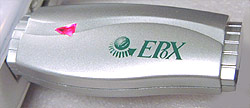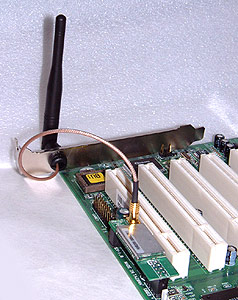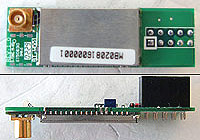Bluetooth is new technology that consumers have been hearing
rumblings about for some time now. It is finally starting
to show itself outside of the trade show floors which is a pretty cool thing in
itself.
What Bluetooth really represents is a "wireless personal
connectivity standard" and what Bluetooth does is enable short-range wireless
connections between computers or mobile devices which support it.
"Bluetooth" is actually the name of the
standard, which is controlled by Bluetooth SIG
, a large consortium of big companies including; 3Com, Ericsson, Microsoft, Nokia, Agere, IBM,
Intel, Motorola and Toshiba. Investigating
further we find out that chip
in Epox's Bluetooth gear is made by Cambridge Silicon Radio ( www.csr.com). While we can't tell for sure, we expect the chip in use
is the BlueCore2 which is a 0.18 micron
BGA chip with integrated baseband DSP, radio, and on chip RISC
microcontroller.
Bluetooth data transfer rates hover
around 723Kbps (Kilobits ) over a max +4dBm
2.4GHz wireless signal. The 2.4GHz ISM band is the same one used by many
cellphones, and 802.11b wireless LAN, but the two are not interoperable. The Epox
adaptors have a listed range of about 30 meters in an open, unobstructed area. Once
you start putting things like walls, people, and computers in the way of
the transceivers that distance can be cut down.
"Unlike many other wireless standards, the
Bluetooth wireless specification includes both link layer and application layer
definitions for product developers which supports data, voice and
content-centric applications. Radios that comply with the Bluetooth wireless
specification operate in the unlicensed, 2.4 GHz radio spectrum ensuring
communication compatibility worldwide. These radios use a spread spectrum,
frequency hopping, full-duplex signal at up to 1600 hops/sec. The signal hops
among 79 frequencies at 1 MHz intervals to give a high degree of interference
immunity. Up to seven simultaneous connections can established and
maintained."
|

|
| Services supported:
Dial-up Networking, Fax, File Transfer, Information
Exchange, Information Synchronization, Network access. |
Bluetooth operates in a "client" and "server"
framework. With a wireless connection the client sends out a request to the server asking for
a connection. The server, which can be a remote computer, mobile device or even
a printer must accept that request before a connection can be established. Most
Bluetooth devices can operate as both client and server, and the software needed
to setup that connection runs in the background.
Once again though, with its maximum transfer speed
sitting at 732 Kbps, Bluetooth is not really intended for
LAN gaming or internet sharing home networks. It's good for sending things to a
Bluetooth compatible printer like the kind HP have recently put to market,
or for transferring small files between adjacent computers.
 |
 |
| Antenna and Transceiver |
Bluetooth Transceiver |
To test out the Epox Bluetooth setup,
we connected the transceiver to the 8K5A2+ and the dongle to another computer located a few feet
away. A 1 MB dummy file was transferred between the two
computers and this took approximately 18 seconds to complete.
Bluetooth is a very simple,
and fairly robust wireless system which is easily implemental, and ideally suited
for small data transfers between computers, mobile devices or peripherals like printers. Now,
let's have a look the overclocking options in the 8K5A2+ BIOS...
